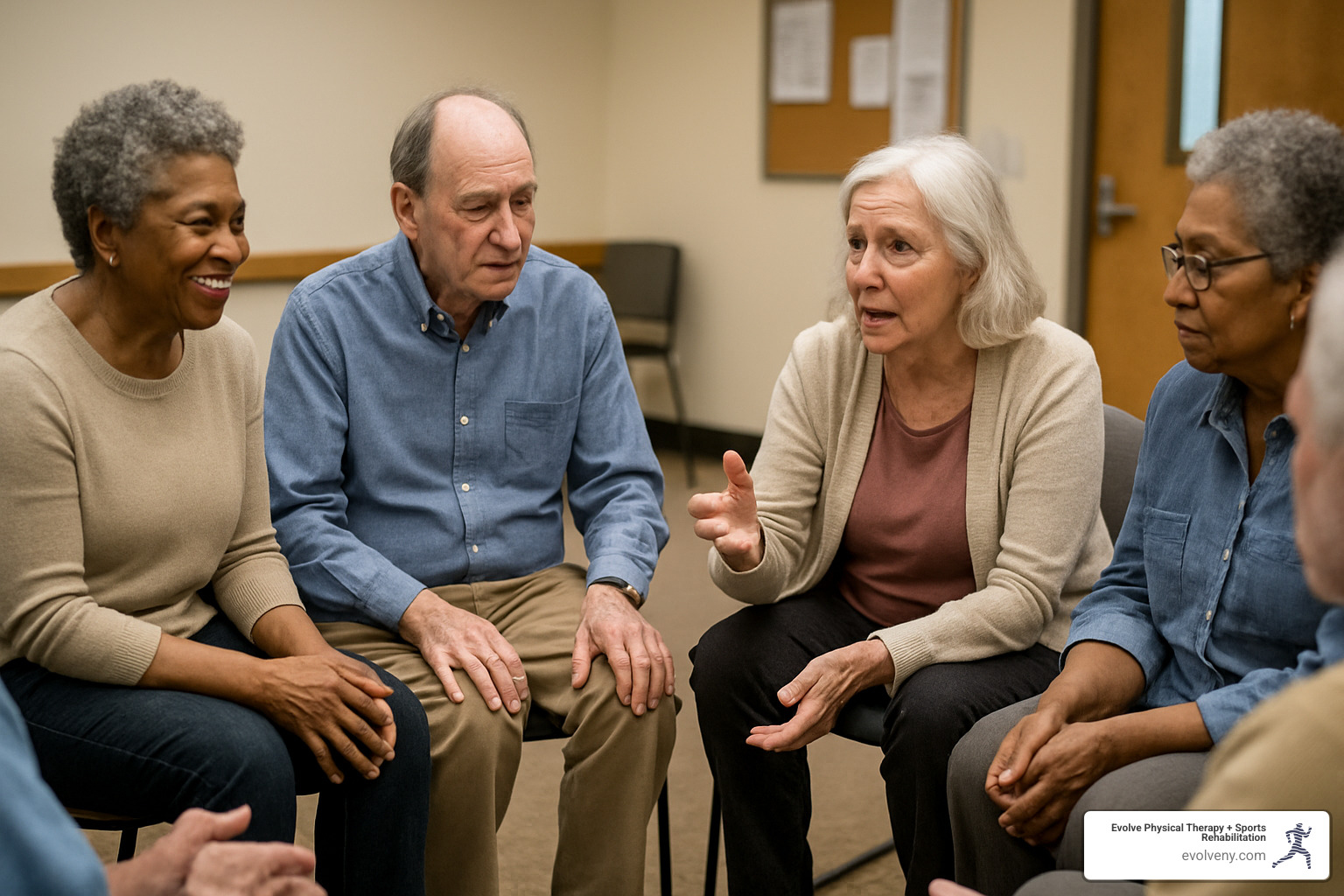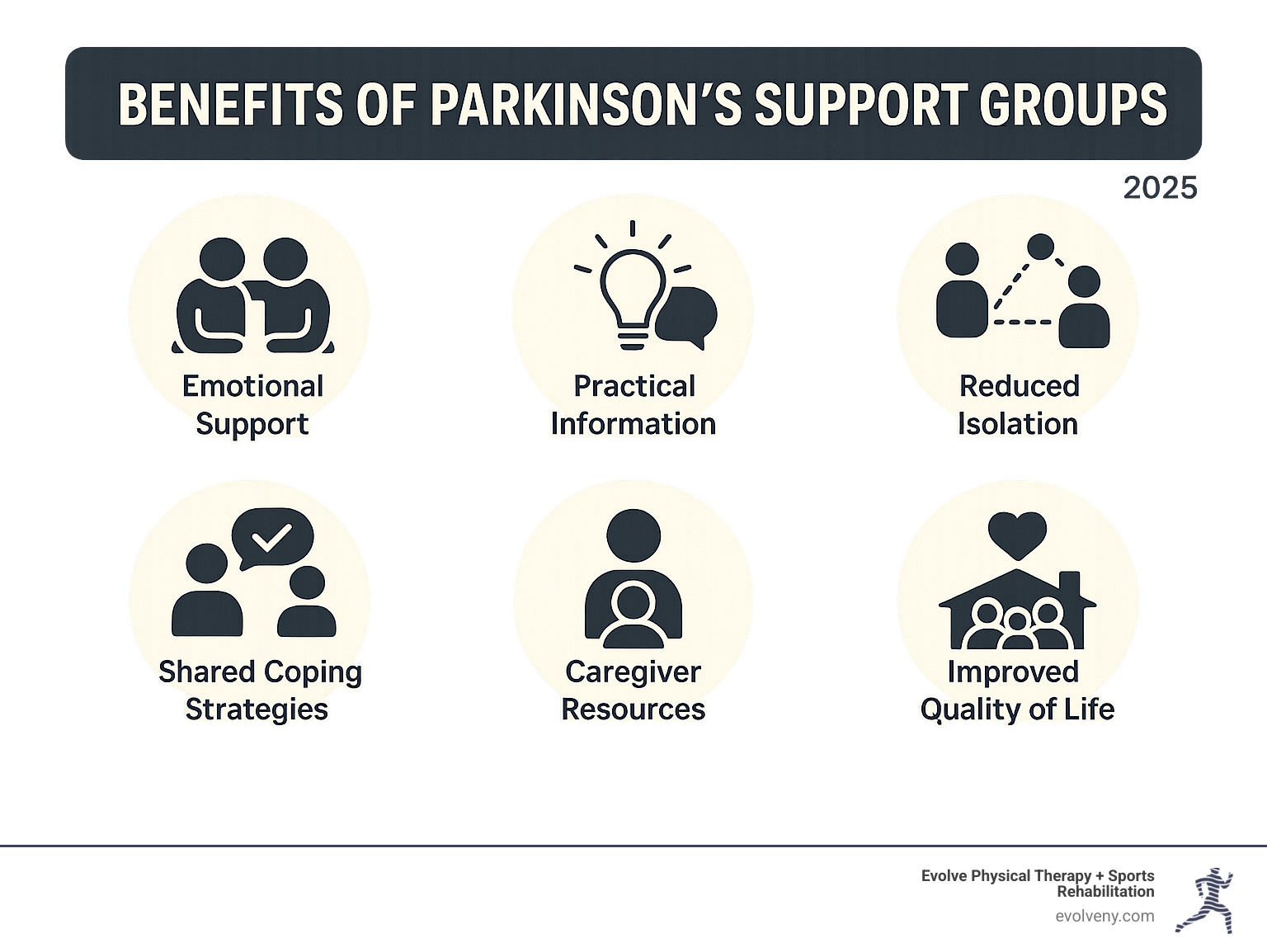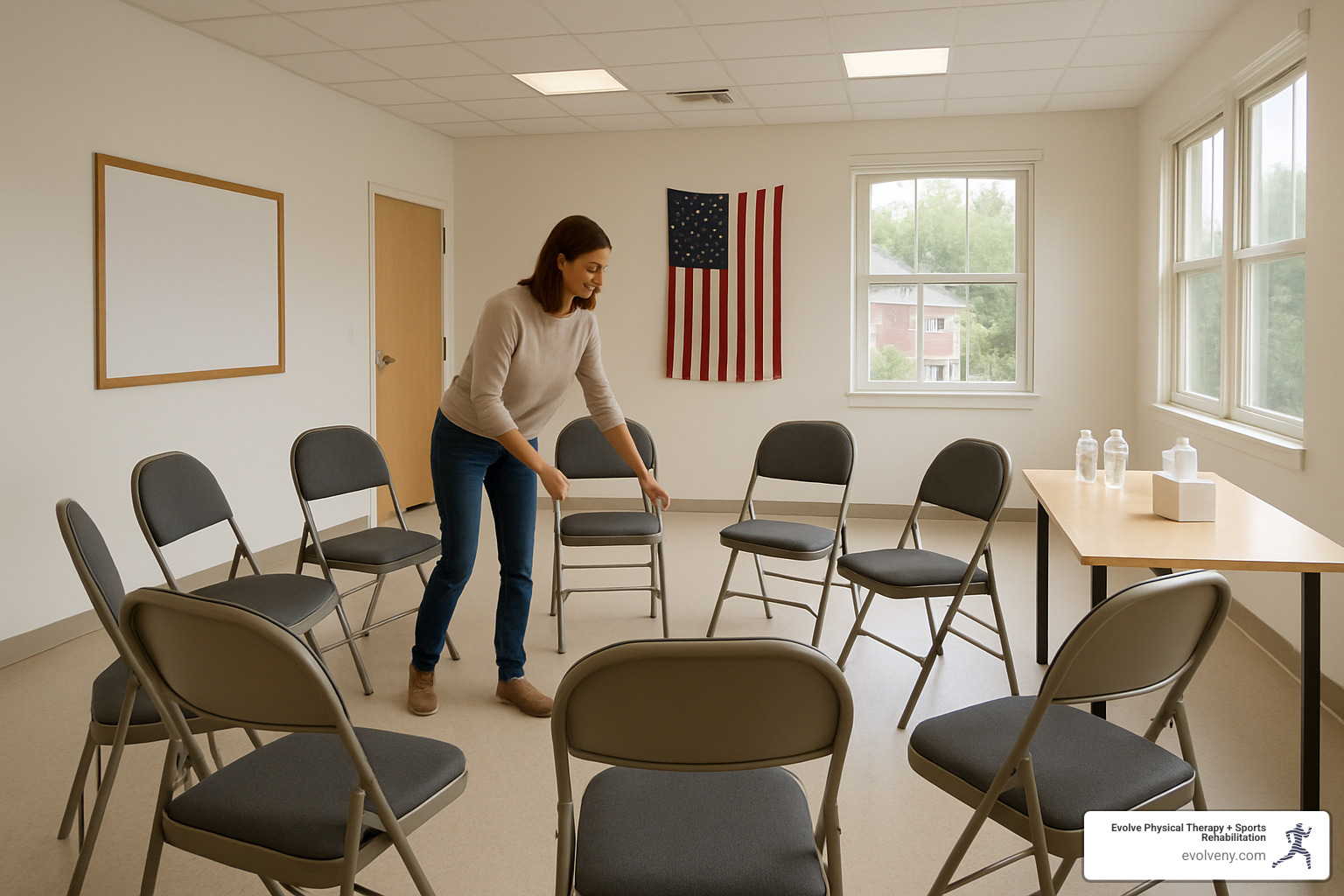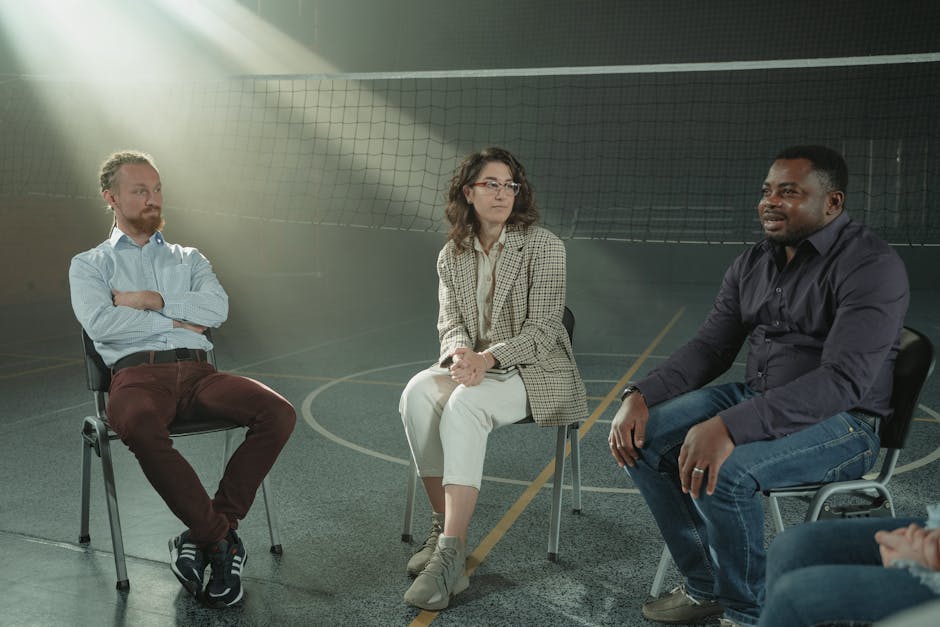Parkinson's Support Group 101: How to Get Started
Why Community Connection Matters for Parkinson's Patients

How to form a support group parkinsons is a crucial question many families face after diagnosis. Living with Parkinson's disease can feel isolating, but creating a supportive community can transform the journey from one of struggle to one of shared strength and hope.
Quick Steps to Start a Parkinson's Support Group:
- Define your audience - Decide if you'll serve people with PD, caregivers, or both
- Find a location - Libraries, community centers, churches, or hospitals often offer free meeting spaces
- Set a schedule - Monthly meetings of 90 minutes work best for most groups
- Recruit initial members - Contact neurologists' offices, physical therapy clinics, and local hospitals
- Plan your first meeting - Focus on introductions, ground rules, and building connections
- Establish ongoing structure - Create consistent meeting formats with discussion topics and occasional guest speakers
A Parkinson's diagnosis doesn't have to mean facing challenges alone. Research shows that support groups spend about 75% of their time sharing practical information and tips, while 25% focuses on emotional support - proving that these gatherings serve as vital resources for both knowledge and connection.
The therapeutic benefits of peer support are well-documented. As one support group facilitator shared: "The people there just got it. I didn't have to explain things to them – they were living with the same challenges that I was living with."
I'm Lou Ezrick, a physical therapist with nearly two decades of experience helping people with neurological conditions, including Parkinson's disease, regain function and build supportive communities. Through my work at Evolve Physical Therapy, I've seen how learning how to form a support group parkinsons can create lasting networks that improve both physical and emotional well-being.

The Power of Connection: Why Start a Parkinson's Support Group?
When Parkinson’s enters someone’s life, everyone around them feels the ripple. A support group turns that ripple into a circle of care. Research shows that roughly 75 % of meeting time goes to sharing practical tips, with the rest devoted to emotional support, so members leave with both information and encouragement.
The Parkinson Association of the Carolinas backs nearly 90 volunteer-run groups; each one proves that informed, connected people cope better and feel less isolated. Social connection is not a luxury—studies link it to slower physical decline, lower rates of depression and higher quality of life.
One member put it best: “Being able to meet people from so many walks of life to discuss this disease we have in common is so good for me.”
More info about caregiver support for Parkinson's.
Benefits for People with Parkinson's
- Realize they’re not alone
- Exchange proven strategies for symptoms, exercise and medication
- Boost mood by celebrating small victories
- Stay socially engaged through regular meetings
More info about conquering Parkinson's Disease.
Benefits for Care Partners and Family
Care partners juggle fear, fatigue and guilt. A dedicated or combined group lets them speak openly, learn stress-management tactics and find respite resources—key tools for preventing burnout.
More info about Parkinson's caregiver support groups.
Laying the Groundwork: Defining Your Group's Focus
When you're figuring out how to form a support group parkinsons, the most important step happens before you even find a meeting room. You need to get crystal clear on exactly who you're serving and what kind of support they need most.
Think of this as creating your group's foundation. Without a clear focus, you might end up with a group that tries to be everything to everyone - and ends up helping no one very well. The most successful support groups know their audience inside and out.
Your target audience shapes everything from where you meet to how you structure conversations. A group for newly diagnosed people will have completely different needs than one for caregivers who've been in this journey for years. Taking time to define your focus now will save you headaches later.
You'll also need to decide on your group type - will you meet in person, virtually, or use a hybrid model? Each approach has its own benefits and challenges. In-person groups create stronger personal connections, while virtual meetings can include people who might not otherwise participate due to mobility or transportation issues.
Writing a simple mission statement and setting clear goals helps potential members understand what to expect. It doesn't need to be fancy - just honest about what you hope to accomplish together.
Choosing Your Target Audience
The beauty of Parkinson's support groups is that there's no one-size-fits-all approach. Different people need different types of support, and that's perfectly okay.
People with Parkinson's only groups create a safe space where members can talk openly about symptoms, medication side effects, and daily frustrations without worrying about how their words might affect family members. These groups often dive deep into practical strategies for managing tremors, dealing with "off" times, or navigating social situations.
Care partners and family members face their own unique challenges that deserve dedicated attention. In caregiver-only groups, people can honestly discuss the stress of watching a loved one struggle, relationship changes, and their own needs without feeling guilty. These conversations are essential for preventing burnout.
Combined groups that welcome both people with Parkinson's and their care partners offer the richest perspectives, but they require skilled facilitation. Some topics might be sensitive when both parties are present, so you'll need to create ground rules that help everyone feel comfortable sharing.
Young-Onset Parkinson's Disease (YOPD) groups serve people diagnosed before age 50, who often face concerns about career impact, parenting with Parkinson's, and social situations that older adults might not relate to. These groups might be smaller but can be incredibly valuable for this specific population.
Newly diagnosed groups focus on the immediate questions and concerns that arise after diagnosis. These members need different support than people who've been living with Parkinson's for years.
Some communities even find success with gender-specific groups, recognizing that women and men may experience different symptoms and have different support needs.
Comparing Different Types of Parkinson's Support Groups
| Group Type | Best For | Potential Challenges |
|---|---|---|
| People with PD | Open discussion of symptoms, medications, and daily challenges without concern for family impact | May lack caregiver perspective on practical daily management |
| Care Partners | Honest discussion of caregiving stress, relationship changes, and personal needs | May feel isolated from understanding the patient experience |
| Combined | Comprehensive support addressing both patient and caregiver needs | Balancing different perspectives; some topics may be sensitive |
| YOPD | Career concerns, parenting challenges, social situations unique to younger adults | Smaller potential member pool; may need broader geographic reach |
| Virtual | Accessibility for those with mobility issues or in remote areas | Technology barriers; less personal connection |
The key is choosing what serves your community best. Don't feel pressured to serve everyone - it's better to do one thing really well than to spread yourself too thin. You might even find that your area needs multiple types of groups to truly meet everyone's needs.
You can always adjust your focus as you learn more about what your members need most. The goal is to start with a clear vision and build from there.
The Step-by-Step Guide on How to Form a Support Group Parkinsons

First Steps
- Pick an accessible space – libraries, community or senior centers, hospitals and churches are usually free and have ramps, elevators and nearby parking.
- Choose a consistent schedule – once a month for about 90 minutes. Mornings often work well, but poll your core group.
- Recruit 3-5 founding members through neurologists, PT clinics, hospitals and your personal network. A tiny start is fine.
Structuring Your First Meeting
Sample 90-minute agenda
0-30 min – Introductions & personal stories
30-45 min – Purpose, goals and simple ground rules (confidentiality, respect, no medical advice)
45-65 min – Open discussion on a pre-chosen topic
65-80 min – Brainstorm future topics and volunteers
80-90 min – Wrap-up and confirm next date
Collect names, preferred contact method and how they heard about the group.
Spreading the Word
- Post flyers in clinics, pharmacies and community bulletin boards
- Ask local neurologists and therapists to mention the group
- Submit to community calendars and share on social media or neighborhood apps
- Register with national organizations such as the Parkinson's Foundation
Word-of-mouth from satisfied members remains your most effective outreach tool.
Leading with Empathy: The Art of Facilitation

You don’t need medical credentials to lead—just curiosity, kindness and the ability to keep a conversation flowing.
Essential Skills
- Compassion & active listening
- Light structure: a loose agenda and start/stop on time
- Clear communication and gentle redirection when one person dominates
- Delegation—share tasks like refreshments or topic research to prevent burnout
Improve your facilitation with these Listening Skills from the Center for Creative Leadership.
Keeping Discussions Productive
- Open with a quick “check-in” round.
- Use open-ended questions: “What has helped you with…?”
- Redirect politely: “Great point, Joan. Let’s hear from others too.”
- Tackle tough topics by acknowledging feelings; solutions are secondary to listening.
- Refresh content with guest speakers—local neurologists, PTs, OTs, SLPs or a Rock Steady Boxing coach.
More info about Parkinson's boxing classes as a group activity.
Sustaining Your Group: Resources and Navigating Challenges
After the launch, focus on three things: welcoming newcomers, sharing leadership and addressing bumps quickly.
Welcoming New Members
Pair each newcomer with a “buddy,” re-state ground rules at every meeting and send a quick follow-up email or call after their first visit.
More info about online support groups for Parkinson's Disease.
Common Challenges & Simple Fixes
| Challenge | Quick Fix |
|---|---|
| Disagreements | Emphasize personal experience, not one-size-fits-all solutions |
| Misinformation | Gently correct and remind everyone to consult healthcare providers |
| Grief or progression | Allow space, share memories, provide counseling resources |
| Disruptive behavior | Re-state norms privately; pause membership if needed |
| Facilitator fatigue | Rotate roles, take breaks, ask for a co-leader |
Regularly ask, “What’s working? What could be better?” Groups that adapt stay vibrant.
Access Tools for Support Group Leaders from the Parkinson's Foundation.
Frequently Asked Questions about Forming a Parkinson's Support Group
Do I need to be a Parkinson’s expert?
No. Your job is to create a safe, well-organized space. Members supply the lived wisdom, and healthcare questions go back to professionals.
How much will it cost?
Usually very little. Most libraries, community centers or hospitals provide rooms for free. Optional costs like flyers or light refreshments can be covered by small, voluntary donations.
What if only a few people come?
That’s a perfect start. Small groups build trust quickly and become your best ambassadors when they invite others.
Conclusion
Learning how to form a support group parkinsons is ultimately about creating a space where people don't have to face their challenges alone. Through our exploration of the essential steps - from defining your group's focus to navigating ongoing challenges - we've seen how these communities become lifelines for both people with Parkinson's and their families.
The journey of starting a support group mirrors the journey of living with Parkinson's itself: it requires courage, persistence, and the willingness to reach out for help. But the rewards are immeasurable. As one group member beautifully expressed: "Everyone in our group knows they are not alone in this journey."
Remember these key principles as you move forward:
Start Small and Build Gradually: Even 3-5 committed members can create a strong foundation. Focus on quality connections rather than quantity.
Accept Shared Leadership: The most sustainable groups distribute responsibilities among members, preventing facilitator burnout and increasing everyone's investment in the group's success.
Stay Flexible: Be willing to adapt your format, timing, and approach based on what works best for your specific group and community.
Connect with Resources: Organizations like the Parkinson's Foundation offer valuable tools and support for new group leaders. You don't have to figure everything out alone.
Focus on Connection: The most important element isn't having all the answers - it's creating a safe space where people can share their experiences and support each other.
At Evolve Physical Therapy + Sports Rehabilitation, we understand the power of community in healing and growth. Our specialized programs, including Rock Steady Boxing for Parkinson's patients, complement the emotional and social support that groups provide with targeted physical interventions designed to help people maintain their independence and quality of life.
The decision to start a support group is a gift not just to yourself, but to everyone in your community who will benefit from the connections and support you help create. Every successful support group started with one person who saw a need and decided to act. That person could be you.
Your community is waiting for the support and connection that only you can provide. Take the first step today - reach out to potential members, secure a meeting location, and begin building the network of support that will make a difference in countless lives.
Learn more about our dedicated Parkinson's physical therapy programs in Brooklyn.



